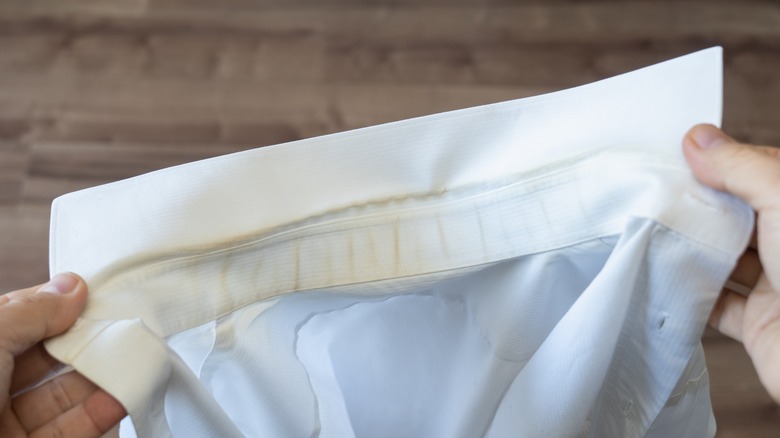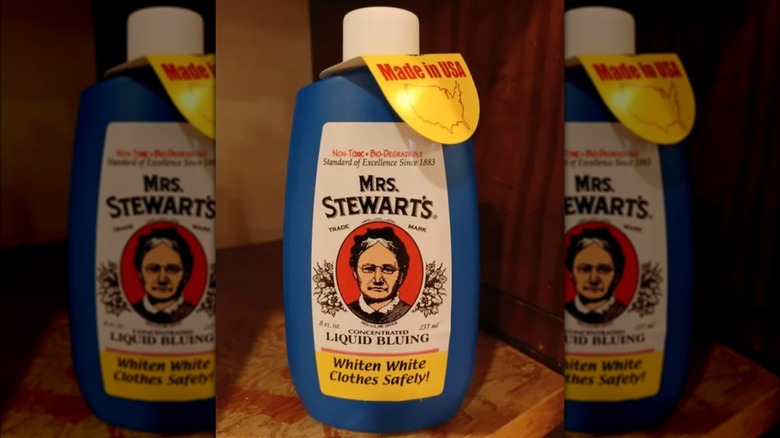Banish Yellow Discoloration From Whites With A Game-Changing Laundry Product
When it comes to your white fabrics, there are stains, and then there is yellow discoloration. While stains can be fought with store-bought products or substitutes for stain removers like baking soda, yellow discoloration can be trickier to remove. Luckily, bluing liquid agents like Mrs. Stewart's Liquid Bluing, which you can find at Walmart for around $10 for two 8-ounce bottles, were created just to combat this issue. These non-toxic bleaching agents can make your white pieces look brand-new.
When you purchase new white fabrics, the crisp color features blue undertones, which is why the piece looks so striking. Whites with a blue undertone appear clean and snowy white. Clothing manufacturers add bluing to white fabrics when they are in the factories to ensure each fabric falls under this hue, but over time, the bluing can wash out. Once it disappears, white items can turn yellow with age, wear, and tear. Though bleach is usually associated with preserving whites, yellowing can actually be caused by this liquid, as it can be very damaging to fabrics and leave them susceptible to turning yellow (or gray in some cases). Sweat is another big cause of discoloration in whites, as well as washing your whites with your colored clothes. Fix your yellowed garments by learning how to use liquid bluing in your laundry.
Liquid bluing can combat yellow tones
If you want clothing to last longer, it can help to use Mrs. Stewart's or similar bluing liquids which don't rely on the harsh chemicals found in bleach to fix discoloration. Made from blue iron salt, laundry bluing is less abrasive and combats the real issue, which is the loss of bluing. Since bleach doesn't actually revive the blue undertones in materials anyway, it can't always bring whites back to their original color.
Therefore, using liquid bluing is one way you can brighten whites without using bleach. To properly use this product, combine ¼ teaspoon of bluing liquid with a quart of cold water. Without being properly diluted, bluing can stain clothes, which is why it is important to follow the instructions on the bottle. If you're using a washing machine, add in your bluing mixture during the wash cycle or when the machine is on a rinse cycle. The official website notes that your machine water should turn a lighter shade of blue. If you prefer to hand-treat items, wash them according to the instructions on the tag, then combine two or three drops of bluing liquid with cold water and submerge your pieces before hang-drying them.
Caveats to using liquid bluing
The biggest drawback of using bluing liquid is that too much can dye or stain whites with a blue tint. It's important to always dilute the solution so the color of the water is a light, sky blue, otherwise clothing can pull in too much of the blue color. While a small amount of Mrs. Stewart's will counter yellow stains or tints, a lot of it will give you a load of blue-hued whites. When it comes to using a bluing agent, just remember that more isn't always better.
Another key piece of information to remember when using liquid bluing is that it can't change various white shades to a snow-white color. In fact, according to the website, combining the proper amount of bluing into your laundry with off-white pieces, beige fabrics, or even cream materials could help make them brighter, but whatever color the piece was when you purchased it cannot be altered by Mrs. Stewart's Bluing. It can combat yellow discoloration, but this liquid isn't equipped to remove stains either, so always treat clothing with the recommended stain removal solutions before adding the bluing. Remember that this product will only help brighten fabrics and not fight marks left by food, dirt, and general detritus.


